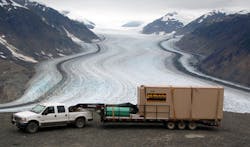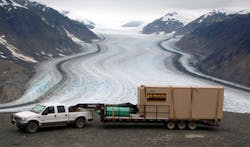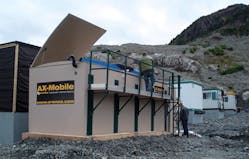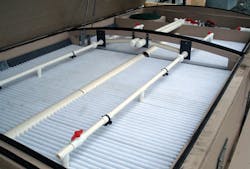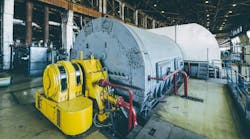by Ted Kulongoski
Originally constructed in 1971, the Granduc Copper Mine outside of Stewart, British Columbia, was a mother lode of copper deposits -- producing hundreds of millions of pounds in its heyday. But, in the 1980s, when the mountainous terrain and rugged site conditions began to outweigh the plummeting price of copper, the mine was shut down.
In 2010, Castle Resources, a Toronto-based junior mineral development company, became interested in the Granduc Copper Mine and has since discovered substantial copper mineralization beneath the original workings. The company acquired the mine with the goal of restoring it to working order.
The first order of business was to refurbish a 10.6-mile tunnel that would provide vehicle access to the mining site. To do that, a camp was needed to accommodate the 25-person work crew. However, the icy and often formidable conditions of the location presented numerous challenges, including the provision of wastewater treatment for employees in a remote and isolated area.
Like many remote mining camps located high in the mountains, the ability to treat and discharge wastewater is limited due to shallow bedrock, little or no mineral or organic soils, and a high water table. Without a working wastewater treatment system, the employees were digging pit latrines to dispose of their waste, which they covered with a privacy structure. These rustic facilities were cold, cramped and malodorous. When a latrine pit was full, a new hole would have to be dug and the privacy structure moved, not an easy task with more than 10 feet of snow on the ground.
The tunnel work camp was in need of a portable and completely self-contained wastewater treatment system. Moreover, because of the camp's environmentally sensitive location and limited accessibility, there were a number of additional requirements: effluent discharge targets of 30/30 mg/L BOD5 and TSS, easy installation, easy maintenance, energy efficiency, and a turnkey operation.
Identifying the Solution
Castle Resources retained Eerik Lilles, P.Eng., owner of a British Columbia wastewater company, Wildernest Systems Inc., to propose a solution. Lilles, in turn, contacted Tristian Bounds, P.E., at Orenco Systems, an Oregon company specializing in the design and manufacture of energy-efficient wastewater treatment systems. Together, they determined that one of Orenco's AdvanTex® Treatment Systems -- the AX-Mobile -- could meet all of Castle's requirements.
"Our goal at Wildernest Systems is to protect human health and the environment -- one system at a time," Lilles said. "In this respect, the product developed by Orenco does much of the heavy lifting. Together, we're able to navigate the regulatory minefield, ensure that the system provided is suitable for the application, and coordinate equipment supply, installation, monitoring, and maintenance."
The installation began in August 2011 and the system was commissioned in September. Total time from site investigation to start-up was about eight weeks.
How It Works
Orenco provided a suite of products that were customized to fit the unique, glacial environment of the work camp. The treatment system is compact and mobile; consumes little energy; requires relatively minimal operation and maintenance; and can be installed easily.
The heart of the system is an AdvanTex AX-Mobile 75-21 Combo unit, a 21-foot-long wastewater treatment system that includes both primary and secondary treatment. It was delivered by truck and trailer to the site, where installers simply plumbed the inlet/outlet connections and then hooked up the power.
Wastewater from the camp drains by gravity through four-inch pipes to an Orenco 30-inch-diameter solids pumping station, which houses two sewage pumps (1/2 hp; 230 vAC; 60 Hz; single phase). The pumping station uses water level floats to monitor the wastewater and activate the sewage pumps when wastewater levels reach a predetermined volume. Sewage pumps convey the wastewater from the pumping station to the treatment unit.
The primary treatment compartment has sufficient volume to provide approximately two days of hydraulic retention time, given a camp occupancy of 25 people. Then the primary treated effluent flows by gravity through an eight-inch Biotube® Effluent Filter before entering the recirculation/blend compartment. In the recirculation/blend compartment, this filtered effluent mixes with secondary treated filtrate returning from the AX-Mobile's patented textile media filter. This blended wastewater recirculates an average of four times before it passes to the discharge compartment for final dispersal. Two, high-head turbine effluent pumps (1/2 hp; 50 gpm; 230 vAC; 60 Hz; single phase) are used to recirculate the wastewater.
Two high-head turbine effluent pumps (1/2 hp; 30 gpm; 230 vAC; 60 Hz; single phase) are located in the discharge compartment of the treatment system and pump the secondary treated effluent through two UV Pure Hallett-30 Ultra-Violet (UV) disinfection units, which were installed in an external cabinet attached to the end of the treatment system. The disinfection units are engineered to be virtually maintenance-free, and their small footprint and compact size minimizes cost per square foot. Pre-installed at the factory into the treatment unit, there was no additional assembly required onsite.
After disinfection, the effluent is dispersed via subsurface discharge.
The entire treatment system is controlled and monitored by an Orenco TCOM™ Remote Telemetry Control Panel that was pre-installed in a second external cabinet adjacent to the UV cabinet. The TCOM control panel includes a touch screen for viewing system data logs, as well as real-time monitoring or adjusting of the system's operating settings, including its liquid level sensors, pumps and UV disinfection units. The panel can be connected to a landline, cellular service, Internet network, or satellite service, allowing Orenco technicians at their headquarters in Oregon to assist in real-time system monitoring, operation and maintenance, and troubleshooting of the system.
The Granduc Mine project was the first installation of its kind for Wildernest Systems. Since then, Lilles has provided similar systems to support mines and communities throughout British Columbia.
While the company works on a wide array of projects, Lilles noted that "with our first AX-Mobile installation, we realized the value of this product and all that it has to offer to this industry and other remote applications, as well as community applications."
"We feel it's our responsibility to bring this new technology to the attention of our prospective clients and explain its benefits, not only in providing robust reliable treatment at one site but also in having a modular, portable system that can then be moved to future sites," Lilles said. "With a more conventional approach -- even if a conventional approach were possible -- there would typically be little or no value to the system at the end of a job. Speaking from an engineering and sustainability angle, this is where we start to see ‘product life-cycle' considerations, which is a relatively new concept in the field of mining and exploration."
Looking Ahead
In February of 2013, Castle published a Preliminary Economic Study on the Granduc Mine, emphasizing that its next major step is to further rehabilitate certain underground areas of the mine so that miners can definition-drill a mineable reserve for a feasibility study. However, as a public company, Castle is subject to the unreliability of capital markets, and in today's climate, financing is difficult. Castle is currently seeking alternative forms of financing to take the project forward. In 2014 and 2015, Castle plans to continue its underground rehabilitation in order to begin production of copper concentrate in 2016.
About the Author: Ted E. Kulongoski, EIT, handles Canadian projects as one of Orenco's International Territory Managers. He speaks four languages and has worked for several international organizations, including the World Bank and Oxfam, where he was responsible for inspecting sanitation-related infrastructure in Indonesia. In addition to a BS in Environmental Engineering, Kulongoski has earned a BA in Biology and an MS in Environmental Systems.
